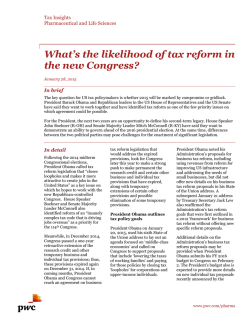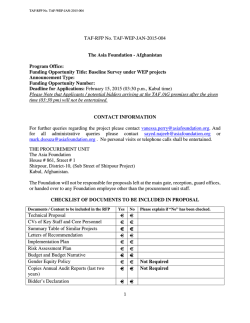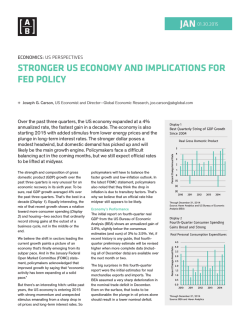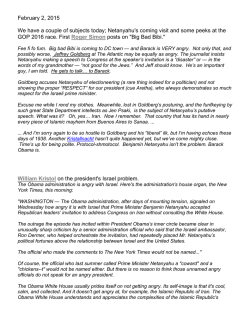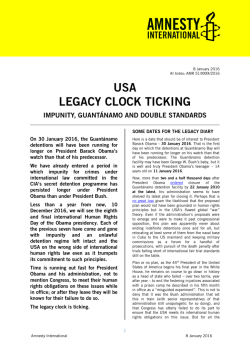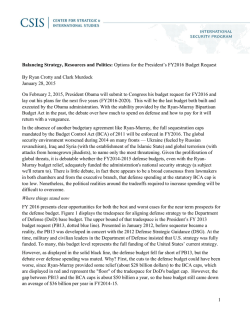
PDF of this statement - Center on Budget and Policy Priorities
CBPP STATEMENT 202-408-1080 [email protected] www.cbpp.org Revised February 4, 2015 Contact: Shannon Spillane, 202-408-1080, [email protected] Statement of Robert Greenstein on the President’s 2016 Budget President Obama is proposing a surprisingly ambitious budget that would make progress — in some cases modest, in others large — in various areas in which policy sclerosis has prevented the nation from addressing significant problems. It would expand opportunity, especially for children; reform various programs and tax incentives to make them more effective; and help large numbers of middle- and lowincome families while scaling back inefficient tax shelters that mainly benefit those at the top. The budget should also strengthen economic growth. It would curb tax-driven economic distortions and invest part of the savings in initiatives that should make the labor force larger and more productive, such as pre-school education and child care, improved college access, stronger tax incentives for people to work, and much-needed infrastructure investments. Along with financing such investments, the plan would use some of the new revenue and program savings for deficit reduction. It would make modest but useful progress here, providing more than $1 trillion in deficit reduction over the next ten years (not counting the savings from winding down overseas wars). In essence, the plan reflects the judgment, with which we concur, that the nation faces two kinds of serious deficits — in the long-term fiscal arena, but also in crucial areas that need resources. Despite its investments, however, this is not a “big-spending budget,” contrary to some claims. Total federal spending over the next ten years would average 21.75 percent of gross domestic product (GDP) — identical to the average for the Reagan years. In fact, despite the budget’s proposals to ease the sequestration budget cuts, discretionary spending would fall by 2019 to its lowest level on record as a share of GDP, with data back to 1962. So would non-defense discretionary spending.1 Overall, the budget is rather bold, with an unusual number of major new proposals for a President’s seventh budget. It includes major reforms in such programs as unemployment insurance and crop insurance, as well as in the tax code and immigration, and measures to push federal agencies to conduct more evaluation, collect more data on program effectiveness, and make more evidence-based decisions. Economic Benefits As noted, the budget includes substantial new investments in pre-school education along with program and tax reforms to make college more affordable for millions of middle- and low-income students, which should boost the skills and productivity of the future workforce. To maintain comparability with historical budget data on discretionary spending, these estimates exclude the President’s proposal to move some transportation spending from the discretionary to the mandatory side of the budget. 1 It also would help many struggling families by making child care more affordable and providing tax relief for second earners, making it easier for parents to work. It includes measures to expand opportunities for retirement savings for many workers. The budget makes permanent key provisions of the Earned Income Tax Credit (EITC) and Child Tax Credit that are scheduled to expire after 2017, thereby preventing 16 million people in low- and modestincome working families from being pushed into, or deeper into, poverty starting in 2018. It also would strengthen the EITC for childless workers, as House Ways and Means Committee Chairman Paul Ryan has similarly proposed through a nearly identical proposal. These workers are the sole group that the federal tax code now taxes into poverty. Moreover, the EITC has been shown to raise labor-force participation rates among single parents, and many conservative and liberal experts alike believe a more adequate EITC for childless workers could have similar effects on many young adults. Other tax changes in the budget also appear well-designed to help the economy. The capital gains tax reforms would reduce inefficient tax sheltering as well as the degree to which investors “lock-in” (or hold) their investments rather than employ their investment capital in the most economically productive ways. The budget’s fees on large financial institutions should discourage speculative behavior that could place the economy (and taxpayers) at risk. In addition, the revenue raised by the budget’s transition tax on profits that multinational corporations hold overseas (which is part of the plan’s larger corporate-tax reform proposal) would finance long-overdue investments to modernize the aging U.S. infrastructure, which otherwise will exert a growing drag on growth. For too long, policymakers and pundits have viewed tax reform as consisting solely of cutting tax rates and broadening the tax base. That can prove economically beneficial. But various other tax changes — such as proposals in the Obama budget to lessen tax-induced economic inefficiencies and invest the savings to strengthen human and physical capital — also would benefit the economy, while improving the prospects of millions of Americans. Fiscal Responsibility On the fiscal responsibility front, the budget does more than some initial commentary has assumed, in part because some of its proposals — such as its Medicare beneficiary changes (which are more significant than is widely realized) and its reforms in the tax treatment of unrealized capital gains — would produce savings that grow after the first decade. The Office of Management and Budget estimates that the budget would slightly reduce the debt as a share of GDP over the first ten years and then stabilize it at least through 2040. On the one hand, policymakers will ultimately need to do significantly more on this front. On the other hand, stabilizing the debt over the next 25 years — a fiscally dangerous period in which the vast babyboom generation will enter retirement, driving up costs for Social Security and Medicare — would represent no small accomplishment. Some commentators have misunderstood the budget’s fiscal impacts. In particular, some responded to last week’s disclosure that the budget would include relief from sequestration by arguing that that would violate past budget agreements and aggravate deficits and debt. In reality, the budget would fully offset that relief through savings in entitlement programs and in the vast collections of tax deductions, credits, and other tax preferences known as “tax expenditures.” Rather than violating the Budget Control Act (BCA), which put sequestration in place, the budget would do what the BCA originally intended — achieve deficit reduction through savings in mandatory programs and revenues rather than deeper cuts in discretionary programs. Policymakers never intended for sequestration to occur. They included it in the BCA as a fallback in case the congressional “supercommittee” failed to propose other deficit savings. The Obama budget seeks to do what the supercommittee failed to achieve. The proposal to ease sequestration is also consistent with the 2013 Murray-Ryan deal, which lessened the sequestration cuts for 2014 and 2015 and offset the cost through changes in mandatory programs and receipts. And to the extent that sequestration cuts — which by their nature are temporary — are replaced with permanent changes in entitlement programs and revenues, the amount of long-term deficit reduction should increase. As noted, the Obama budget proposes spending over the next ten years that would equal the Reagan-era average, even with the aging of the baby boomers. In fact, under the Obama budget, total federal spending outside of Social Security, Medicare, and interest payments would drop from 11.7 percent of GDP in 2015 to 10.3 percent of GDP in 2025, well below its 12.2 percent average for the 40 years from 1975 to 2014. Dead On Arrival? Critics suggest that the Obama budget, like those of earlier Presidents, will be “dead on arrival.” They also criticize the President for not heeding the results of November’s elections and moving more substantially toward congressional Republicans on fiscal matters. Such criticisms are off base, however. A President can reasonably outline where he thinks the country should go, rather than what might pass political muster in a fractious Congress. Moreover, congressional Republicans didn’t move their budgets “to the middle” after Obama’s victory in 2012. Both sides will face the true test of flexibility if and when they engage in budget negotiations (as I believe they will in 2015), not in providing their respective visions for the country at the outset. Moreover, it’s in such negotiations — as well as when Congress writes appropriations bills — that policymakers will likely consider some of the proposals in the Obama budget. For any President, the DOA label for his budget usually turns out simplistic and premature as, in the end, lawmakers consider and adopt more of it than the DOA prognosticators had assumed. Finally, important aspects of this budget — with its ambitious proposals and array of reforms — will likely become part of policy debates for a number of years as the nation searches for ways to tackle challenges that we have sidestepped for too long. #### The Center on Budget and Policy Priorities is a nonprofit, nonpartisan research organization and policy institute that conducts research and analysis on a range of government policies and programs. It is supported primarily by foundation grants.
© Copyright 2026



